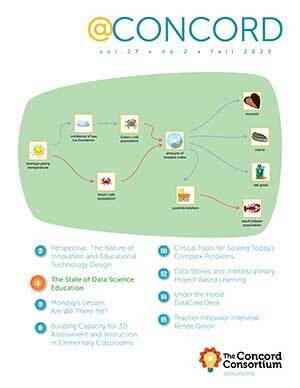Perspective: The Nature of Innovation and Educational Technology Design
Travel offers a portal to many things, but perhaps the most fascinating is the perspective it provides on how humans approach design. To visit a new place is to bear witness to the endless variety of solutions humans create to meet our needs. It was for this reason that I recently found myself pondering what a rubber squeegee and a three-foot-long shoehorn had to do with innovation and educational technology design.
On one family trip, two phenomena intersected: the constant presence of a broom-length rubber squeegee and the regular formation of a large puddle across the tile bathroom floor. During a second trip, an unexpected tool became familiar: a long-handled shoehorn in the entryway of nearly every home we visited.
At first glance, these affordances seem remarkably similar. From a design perspective, however, they represent polar opposites.The squeegee was a workaround to a core design flaw in the bathroom floor, while the long-handled shoehorn presented a solution to a problem we hadn’t realized we had—easily donning shoes for outdoor treks.The contrast between the two offers an important lesson about why and how humans design. It also sheds light on how careful attention to technology design can bring teaching and learning to new levels.
Responding to needs. Workarounds are controversial. On the one hand, they demonstrate the failure of an intended solution. At the same time, they represent important signposts. As design guru Donald Norman observed,“Hacks and workarounds are the soul of innovation.” Designers often see workarounds as signals that someone needs something enough that they have gone out of their way to do something about it.Famous examples abound.An organist needs to reposition taped paper notes in his music; the sticky note revolution is born. Nokia engineers observe people navigating the dark via glowing flip phone screens and invent the smartphone flashlight button.
Education presents some distinct design constraints.While consumers buy products to solve problems they have encountered in the past, by definition learning engages us with things we have not seen or known before, making it often difficult or impossible for learners to know their needs in advance. In addition, consumers typically are free to choose the solutions they purchase, while most educational settings place learners on the receiving end, often providing topics or materials learners may or may not be naturally inclined to choose themselves.These differences impose particular added demands on educational designs. Fortunately, such constraints strengthen the case for new creativity and innovation.The core pursuit remains unchanged. By watching what people desire and reach for, we can design the world to better fit their grasp.
Piggybacking. Author, engineer, and innovation researcher Paulo Savaget likes to explore innovative solutions to problems where resources are scarce and stakes are high. In his book The Four Workarounds, Savaget identifies problem-solving strategies he claims have led to successful solutions to some of the world’s most intractable issues. One strategy, piggybacking, holds particular resonance for the innovations we develop at the Concord Consortium.
Savaget describes piggybacking as the strategy of capitalizing on seemingly unrelated relationships, leveraging something that already exists to bring about something new. This strategy has indeed helped crack some enormous problems. Medical advocates recognized long ago that using salt to deliver crucial trace amounts of iodine could curtail developmental deficiencies for hundreds of millions of people worldwide. More recently, an entrepreneur in ruralAfrica planned to use a soft drink’s ubiquitous presence to create a medicine packet for treating dehydration that fits between bottles in drink crates, taking advantage of a robust distribution network to deliver much-needed treatments.
Though global supply chains may seem far removed from educational technology, with the right lens, key similarities arise. In fact, the strategy of piggybacking is practically second nature to anyone involved in education. To succeed in the complex environment of the classroom, educational solutions demand piggybacking, in this case leveraging learners’ attention and innate proclivities in novel and important ways. Especially at the intersection of STEM learning and technology, such piggybacking is central to designing successful innovations.
Finding and leveraging learners’ curiosity, so they can ask and answer questions they didn’t know they had. This is the key to designing successful STEM educational technology.
The currency of curiosity. Young children are driven by an engine of unflagging curiosity. This fire exists inside everyone, simply waiting to be found and stoked. This is our piggybacking opportunity: finding and leveraging learners’ curiosity, so they can ask and answer questions they didn’t know they had. This is the key to designing successful STEM educational technology.
To do so, we employ the same process designers everywhere use: find the existing interests hiding within a learner’s natural tendencies, then design toward them in a way that makes curiosity inevitable and open exploration the norm. Two questions drive this approach: Where’s the curiosity? and How can we leverage it for engaged learning? In this newsletter issue alone, we see notable examples.
One article describes CODAP’s role in the data science education revolution. At its heart, CODAP as a tool helps answer one question over and over: What’s going on there? By making data visible and explorable, CODAP leverages our human curiosity to make sense of connections and patterns. CODAP’s feature of dynamic linking—in which highlighting a data point in one location highlights the same data in all other representations simultaneously—is at its heart a research-based answer to this recurring question.
Another article offers a readymade lesson using our M2Studio modeling environment, an amazing suite of tools for unlocking the power of mathematical modeling that focuses on one fundamental question: How would that work? By providing a straightforward path for learners to identify a scenario of interest, explore and develop its mathematical underpinnings, and generate explanations via predictive models, M2Studio is a natural laboratory for satisfying curiosity. Its embedded tools are designed to explicitly link across graphical, mathematical, and written modalities.
Another article makes clear that SageModeler is driven by curiosity from the start. While it engages learners in many ways, one of the most vital is how it takes advantage of our need to ask What if I change that? The models in SageModeler do not simply provide an overall depiction of a complex system and its components. Rather, they provide an interactive view of how elements of that system depend upon each other. By moving sliders attached to different nodes and observing the corresponding graphs across the entire system, learners can identify the unusual, emergent dynamics that serve as hallmarks of complex systems.
Whether inside this issue or across our hundreds of resources, the design pattern of using curiosity to encourage exploration plays out repeatedly. MothEd’s data cards entice students by asking What does that represent? and show them connections and relationships in their data collections. Interactive three-dimensional cross-sections in our Earth science tools make asking and answering the question What’s underneath that? second nature. Deliberate use of multiple-screen views in our CLUE learning environment tempts students to ask What does my classmate think? in a way that informs and evokes rich conversations about different strategies and solutions for mathematical and scientific problems.
All these examples comprise the essence of our ongoing quest to innovate and inspire equitable, large-scale improvements in STEM teaching and learning through technology. As we continue to develop and research new ways to leverage technology’s unique ability to enable better learning, we invite you to join us on the journey.
Chad Dorsey (cdorsey@concord.org) is President and CEO of the Concord Consortium.

